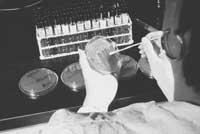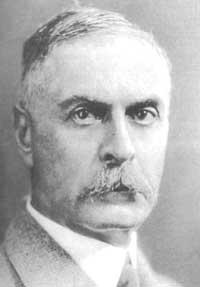Karl Landsteiner, tireless blood researcher

Karl Landsteiner had a very special childhood. At the age of six his father died and since then the relationship between mother and son was very close and curious. He was so curious that when his mother died, his son made him mask his face and hang it on one of the walls of his house. Pessimistic in nature, he did not mix much with people and preferred long and lonely laboratory hours than boring words among friends. Perhaps to this fleeting and dark character we owe much of our current knowledge about the classification of blood and the immune system.
A doctor fascinated by biochemistry
After his first studies, he moved to the University of Vienna to study medicine. From the beginning, the subject he liked most was biochemistry. Before graduating he wrote a paper on the relationship between diet and blood composition. Graduated in 1896 and determined to further delve into the field of chemistry, she worked for the next five years in three laboratories in Zurich, Wurzburg and Munich.
After moving from one place to the other, he went to work at the Vienna General Hospital and returned to his medical studies. In 1896 he was appointed assistant to Max von Gruber at the Vienna Institute of Hygiene. At that time, the main interest of young Karl was to investigate the mechanisms of the immune system. In the following years, from 1898 to 1908, he was a collaborator of the Department of Pathological Anatomy of the University. Head of Department A. Weichselbaum, a scientist who discovered that meningitis can also be caused by infection by certain bacteria. Weichselbaum looked with good eyes at Landsteiner's work and, in 1908, helped him get a self-resisting position at Vienna's Wilhelminaspital Hospital. In 1911 the University of Vienna awarded him the chair of Pathological Anatomy, but nevertheless he did not receive the salary corresponding to this title and continued in Wilhelminaspital until 1919.

During his years of experience, he carried out several studies on pathological anatomy and immunology and published numerous works that reported the findings made with his colleagues. He studied syphilis and polio, among others. To investigate the latter, laboratory monkeys were injected with a substance such as the paste obtained from the grinding of the bone marrow of children affected by the disease and it was discovered that polio was transmitted. When he ran out of the monkey to continue working, he had to go to the Pasteur Institute in Paris. The work carried out in it, together with the work done individually by Flexner and Lewis, formed the basis of current knowledge on polio.
Classification of blood groups
But we certainly know Landsteiner because he did the classification of blood groups. In 1875, Landois published a work on blood transfusions. He says that when a human being is given blood from another animal, these strange blood corpuscles come together and break and hemoglobin is released. Between 1901 and 1903, Landsteiner claimed that blood transfusions between humans could have been the same and that antigens and antibodies were responsible for it. However, scientists in the area did not pay much attention to him until in 1909 the classification of the blood groups of the human being was made. Later, in 1930, he received the Nobel Prize in Physiology and Medicine.
According to this classification there are four blood groups: A, B, AB and O. For its classification it used two cell membrane molecules of red blood cells, antigens A and B. He called blood from group A to the blood that only contained antigen A, which only had antigen B from group B, which had antigens A and B from group AB group AB and which neither had the blood of group O. When one of these antigens does not exist, there is usually the corresponding antibody (anti-A or anti-B), when there are two antigens there is no antibodies and when there is no antigens there are two antibodies. During transfusion it is not possible to attach an antigen to the corresponding antibody.
Retirement between pipettes

Due to the disaster caused by World War I, in Vienna it was impossible to work properly. Therefore, in 1919 he settled in a small Roman Catholic hospital in The Hague (Holland). There he also continued to investigate and published several works on the discoveries made.
In 1922 he was offered to work at the Rockefeller Institute of Medical Research and moved to New York with his entire family. In this city, along with Wiener, he discovered the Rh factor (1941). In general, the one who has D antigen in blood is called Rh+ and the one who does not is called Rh-. When blood transfusions are done, those with Rh can only take blood with Rh. However, those with Rh+ don't have this problem and can catch blood from both groups. This discovery allowed blood transfusions to take place without danger.
In 1939, the Rockefeller Institute appointed him professor emeritus, but despite his right, Landsteiner did not want to abandon the investigation. He continued working until June 24, 1943, while working in the laboratory, his heart failed him. He died two days later, just 75 years old, at the same Institute where he had worked so much.





